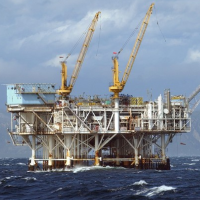More Offshore Fracking Discovered in Southern California Waters
 Drilling off the coast of Santa Barbara (photo: Steve Malone, Associated Press)
Drilling off the coast of Santa Barbara (photo: Steve Malone, Associated Press)
While the state waits for recently-passed legislation that regulates fracking of oil and gas wells to take effect in 2015, a records search prompted by the Associated Press has found more than 200 previously unpublicized instances of its use at vulnerable offshore sites.
When AP revealed in August that offshore fracking (known in more refined quarters as hydraulic fracturing) was occurring without the knowledge of state officials, it identified a dozen instances of energy companies pumping pressurized water, sand and chemicals into the ocean floor. That drilling was taking place in Santa Barbara waters, where a devastating oil spill in 1969 prompted a state moratorium on new offshore oil leases all along the coast.
State officials expressed surprise at the coastal drilling and Alison Dettmer, a deputy director at the California Coastal Commission, told reporters, “It wasn't on our radar before, and now it is.”
But having something on one’s radar and doing something about it are two different things, and the state has not announced any plans to do anything about the fracking, which AP said was conducted 203 times at six sites over the past two decades. The news service used public records to identify the drilling in waters off Long Beach, Seal Beach and Huntington Beach.
But when it contacted Occidental Oil about its fracking in Long Beach, home to the nation’s second-largest container port, it was told the information was secret for “competitive and proprietary reasons.” There is no evidence that fracking in the ocean has resulted in spills or contamination.
The AP report amplified an online story by Truthout the month before that detailed two of the fracking operations.
The Environmental Defense Center documented its unsuccessful attempt (pdf) to get a handle on how much offshore fracking is going on in federal waters, via a Freedom of Information Act request. It found 15 instances of offshore fracking—four this year—but determined “it is almost certain that the FOIA response does not accurately reflect the true frequency and extent of offshore fracking, as officials at BSEE [Bureau of Safety and Environmental Enforcement] appear to have been unaware that fracking was occurring until very recently.”
The center did not hold out hope that the extent of ocean fracking would be known anytime soon by the U.S. Department of the Interior because “its files are apparently not easily searchable.”
One of the fracking sites was identified as Platform Gail, in federal waters of the Santa Barbara Channel. It is near Channel Islands National Marine Sanctuary and Anacapa Island and has a long history of spills, the center said.
The state law passed in September is California’s first attempt to regulate a practice that has been around for decades. It allows fracking to continue unabated until 2015 while regulations are drafted. A mandated statewide environmental impact report on the practice isn’t due until July 2015. And while it does require frackers to reveal what toxic materials they are injecting into the ground, they can keep secret details on the mix of the toxic brew. Critics find the public notification provisions to be ineffectively weak
Environmentalists say the law fails to deliver safeguards against groundwater contamination, air pollution, releases of methane gas, micro-earthquakes and sinkholes.
Fracking foes want a moratorium now until the science is better understood and regulations are in place and active. But pressure has been building on the state to quickly move forward since it became known that the technology might unlock a vast Central California field of oil, known as Monterrey Shale, and yield 15.3 billion barrels of oil.
–Ken Broder
To Learn More:
Calif. Finds More Instances of Offshore Fracking (by Alicia Chang and Jason Dearen, Associated Press)
Dirty Water: Fracking Offshore California (Environmental Defense Center) (pdf)
While Fracking on Land Comes Under Fire, Energy Companies Quietly Do It Offshore (by Ken Broder, AllGov California)
- Top Stories
- Controversies
- Where is the Money Going?
- California and the Nation
- Appointments and Resignations
- Unusual News
- Latest News
- California Forbids U.S. Immigration Agents from Pretending to be Police
- California Lawmakers Urged to Strip “Self-Dealing” Tax Board of Its Duties
- Big Oil’s Grip on California
- Santa Cruz Police See Homeland Security Betrayal in Use of Gang Roundup as Cover for Immigration Raid
- Oil Companies Face Deadline to Stop Polluting California Groundwater





